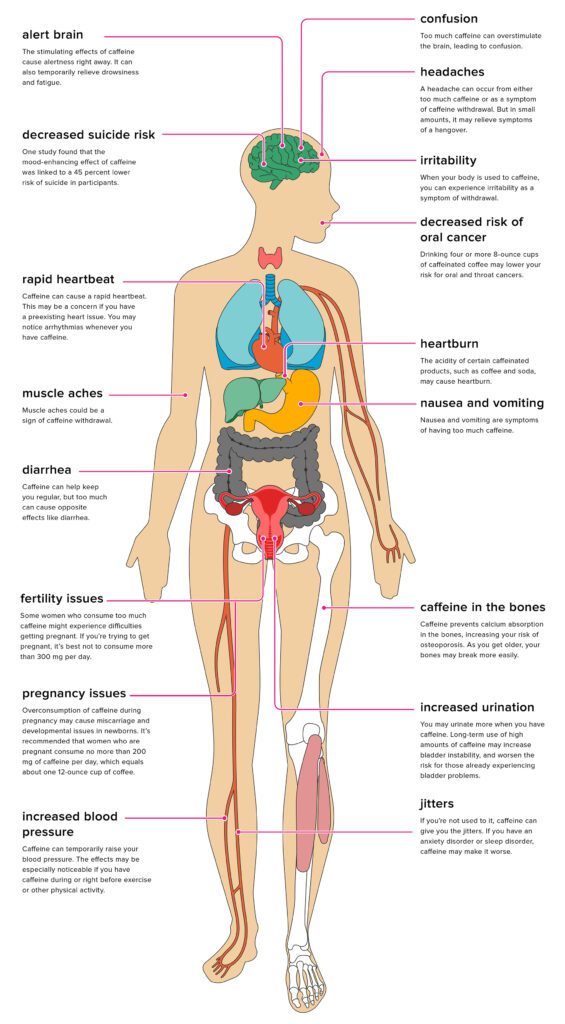Caffeine has been used in pain medication for a while
Caffeine has been used as a medicinal substance since before recorded history, by consumption of caffeine bearing plants. However, the discovery of the chemical did not occur until Friedlieb Ferdinand Runge isolated and purified the white crystalline substance in 1819.
Coffee and tea both contain caffeine, as does natural chocolate
Caffeine is naturally found in the fruit, leaves, and beans of coffee, cacao, and guarana plants. It is also added to beverages, supplements, and some medications.
How does caffeine help with pain management
Science shows this about caffeine and pain management…
The relevance of animal studies to humans is not always clear. In fact, it’s common that findings in medical studies performed in mice or other animals cannot be replicated in humans. This may be particularly true for something as complicated and subjective as pain.
There is precedent in human disease for a potential connection between pain and sleep deprivation. Fibromyalgia is common in the (human) population and it’s marked by chronic, body-wide pain. The cause is unknown, but a leading theory suggests that poor sleep quality may play a role. Treatments that improve sleep quality may help symptoms of fibromyalgia as well.
What was found in human subject studies though, is that caffeine accelerates absorption and enhances the pain-reducing effect of acetaminophen. The combination of acetaminophen and caffeine is a great way to manage post-operative pain as well, especially in patients with gastric ulcers or bleeding tendency because acetaminophen is less hazardous than ibuprofen.
The effects and mechanisms behind caffeine
Caffeine is a central nervous system stimulant that affects your body in numerous ways. If you’ve ever wondered what exactly caffeine does to your body, you’re not alone. Many of us rely on a morning cup of coffee or a jolt of caffeine in the afternoon to help us get through the day. Caffeine is so widely available that the U.S. Food and Drug Administration (FDA), says about 80 percent of U.S. adults take some form of caffeine every day. But caffeine does so much more than just keeping you awake.
Caffeine’s primary mechanism of action is on the adenosine receptors in the brain. As it is both fat and water-soluble, it readily crosses the blood-brain barrier, resulting in effects on all four adenosine receptor subtypes (A1, A2a, A2b, A3). Specifically, the effect on the A2a receptor is responsible for the wakefulness effects of caffeine.
Knowing the symptoms of caffeine and its long-term effects on your body may make you think twice about having that fourth cup of coffee.
Central nervous system (CNS)
As a CNS stimulant, caffeine hits the brain and gives you a sense of “alertness.” This also reduces the effects of sleep deprivation, effectively limiting the heightened sense of pain that comes with sleep deprivation.
Too much caffeine can cause headaches and migraines though, so consume responsibly.
Digestive and excretory systems
Have heartburn? Caffeine increases the production of acid in your stomach which can irritate ulcers and regular heartburn.
Circulatory and respiratory systems
Being absorbed in the stomach, it takes about two hours to reach peak levels in the bloodstream. This can increase your heart rate and blood pressure if you are susceptible to those symptoms without caffeine as well.
As there are multiple constriction and dilatation mechanisms at work, the overall result is individualized and dependent upon caffeine dose, the frequency of use, and co-morbidities such as diabetes or hypertension. Overall, caffeine seems to increase systolic blood pressure by approximately 5 to 10 mmHg in individuals with infrequent use. However, there is little to no effect on habitual caffeine consumers.
Skeletal and muscular systems
Caffeine in large amounts may interfere with absorption and metabolism of calcium. This can contribute to bone thinning (osteoporosis). If you consume too much, caffeine may cause also your muscles to twitch. If experiencing caffeine withdrawal, a symptom may include achy muscles.
Reproductive system
Most women have heard that caffeine consumption is dangerous during pregnancy, but did you know it can also affect your fertility?
Caffeine travels within the bloodstream and crosses into the placenta. Since it’s a stimulant, it can cause your baby’s heart rate and metabolism to increase. Too much caffeine can also cause slowed fetal growth and increased risk of miscarriage. In most cases, a little caffeine is safe during pregnancy.
According to the Mayo Clinic, you should limit caffeine consumption between 200 and 300 milligrams per day if you’re trying to get pregnant. There’s some evidence that large amounts of caffeine can interfere with the estrogen production and metabolism needed to conceive.
So what?
Caffeine has a potential role in pain management. Current evidence on caffeine use for migraine and terminal stage cancer is not well-established in humans though. Future studies should address the use of caffeine alone for different types of pain with dose escalation and standardization of outcome measurement.
Source one. Source two. Source three.
Who we are
The Live Learn Innovate Foundation is a 501(c)3 nonprofit entity that empowers software users to regain control of their personally generated health data, gain intuitive insights about their social data, learn the impact of their environment on health, and build a foundation of data analytics that empowers research, academics, and innovation in economic development.
Use cases for this secure, private method of data aggregation appear everywhere, expanding to family care, community growth, agricultural planning, and many more things still unseen. Help us keep going by getting involved today.

One Response